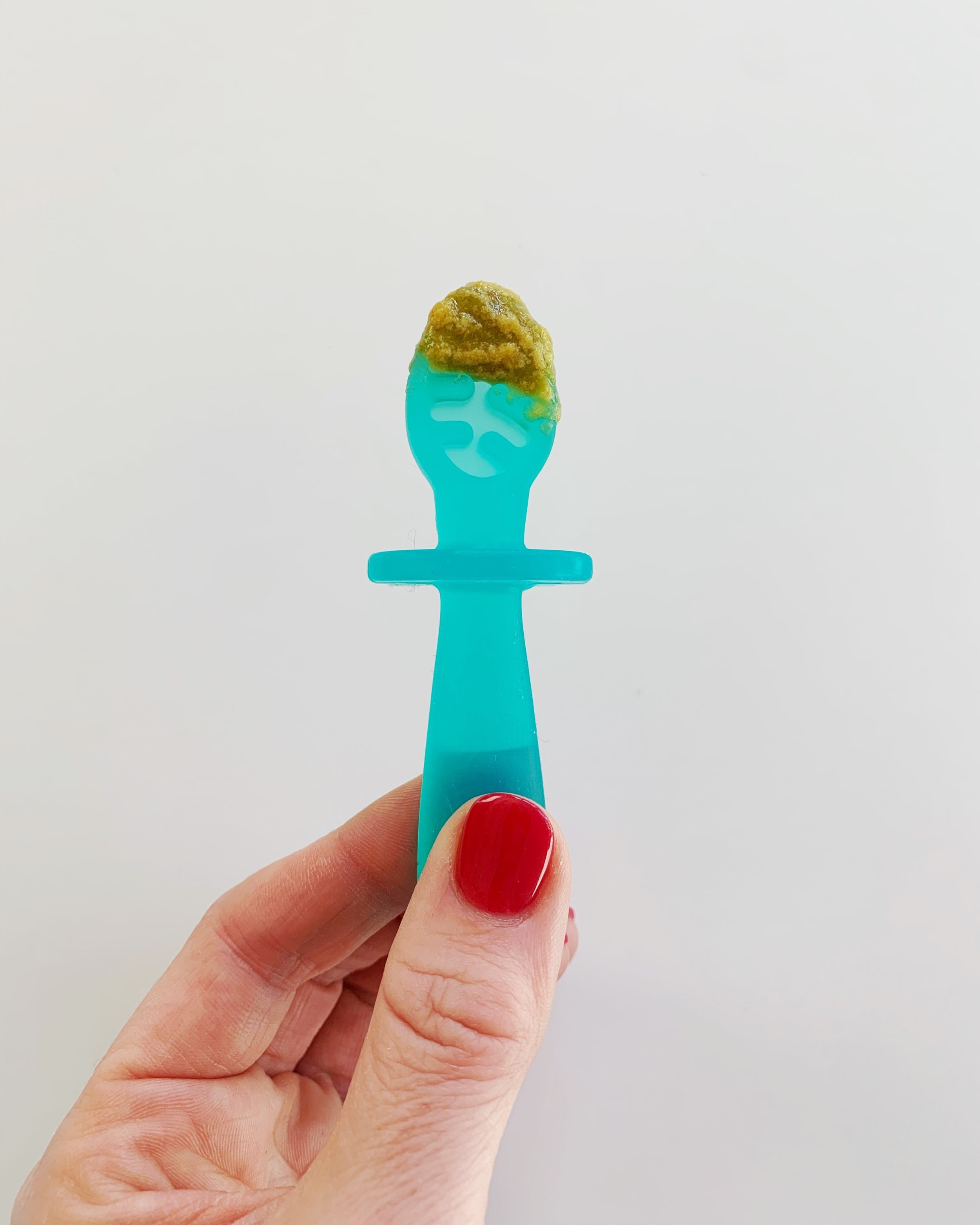Do I Have to Choose Between Baby-Led Weaning and Purees?
Nope... just choose responsive feeding!
If you’re getting ready to start your baby on solid foods, you may have questions about whether it’s best to go the traditional, spoon-feeding of purees route, or to try baby-led weaning (BLW). BLW is a method of starting solids that involves offering baby finger foods from the family table for self-feeding. It’s not about “weaning” per se, but rather an approach that centers around letting the baby lead. The good news is that you don’t have to choose!
Thank you to this sweet one’s parents for allowing to share! An example of a 20-month old eating a puree mixture.
Technically, BLW skips over the passive spoon-feeding of purees, but contrary to popular belief, it does not mean avoiding purees in general. A combined approach that includes both finger foods for self-feeding and the spoon-feeding of purees is fine when babies are fed responsively, and there is no evidence that a combined approach is detrimental.
A misconception about BLW is that purees should be avoided. In fact, puree is an important texture for babies to learn and practice. Older children and even adults eat purees throughout life in the form of foods like yogurt, applesauce, and cream soup. Many feeding therapists tell me that a large part of their caseload are BLW babies who never were offered purees and now struggle with that texture as toddlers, so you can feel confident about offering both to your baby throughout the process of learning to eat.
Feeding purees the BLW way involves pre-loading the spoon and then handing the spoon to the baby to self-feed, which ensures that the baby is leading the process and deciding whether and how much to eat. In addition to offering purees in this way, BLW babies are also offered a variety of finger foods that invite them to explore and maneuver different textures in the mouth.
By somewhere between 7-12 months, the general goal is for all babies to be self-feeding finger foods. BLW offers more opportunities for practice with self-feeding and finger foods early on, however, it’s a personal decision how you choose to introduce solids, coming down to what you’re comfortable with and what works best for you and your baby.
What matters more than deciding between BLW or traditional spoon feeding is feeding responsively. This is the least talked about, but most important part of infant feeding!
Responsive feeding, or responding to baby’s cues of hunger and fullness, offers many positive outcomes for baby as well as reduced stress for caregivers. According to the 2020-2025 Dietary Guidelines for Americans, it helps young children learn to self regulate how much they need. The World Health Organization also recommends feeding baby responsively as part of introducing complementary foods. The American Academy of Pediatrics (AAP) says that responsive feeding early on can reduce a child’s risk of becoming overweight later in life, and contributes to self-feeding. The AAP also says that many caregivers have an easier mealtime experience as well as more bonding opportunities once they’ve adopted a responsive feeding style.
So what exactly is responsive feeding? In a nutshell, responsive feeding involves:
Watching baby for signs of hunger and fullness at mealtimes
Offering more right away when baby still seems hungry
Allowing baby to stop eating right away when baby shows signs of fullness
It sounds simple, but in practice can sometimes be trickier to navigate. For example, baby’s appetite can vary from day to day. One day, a baby might have a hearty appetite and seemingly put away two or three times as much as usual, whereas on other days after a couple of bites the baby may start throwing the rest of the food or turning away the head away when a spoon is offered.
This is actually quite normal; babies go through periodic growth spurts during infancy that influence their needs, and their appetites reflect that growth. As long as a baby seems more or less satisfied after meals, is gaining weight well and regularly filling diapers, caregivers can trust the baby's hunger and fullness cues and continue to offer more or finish a meal early, even if it seems like the baby is eating too much or not eating nearly enough. An irregular intake usually balances itself out over the course of a week or two. If you have concerns about this process or feel like your baby is not eating enough, talk to your pediatrician about it and explore ways to help baby become more interested in solid food.
How can you tell when your baby is hungry? Babies have unique signals for hunger and fullness, but some common signs of hunger include:
Staring intently at food
Leans toward food
Opens mouth wide
Reaches or points to food
Gets excited about food
Uses sounds to indicate desire for food
How can you tell when your baby is full? Common signs include:
Spits out food
Throws or pushes food away
Closes mouth when food is offered
Gets distracted easily
Turns head away or shakes head “no”
Plays with food rather than eating it
During the first few months of life, babies need to eat frequently, but as they age and especially after starting solids, it’s ok to let them go a little longer between meals and/or bottles so that they can come to meals a little hungry and learn that food satisfies hunger. Here is more information on how to navigate feeding schedules by age.
In order for responsive feeding to work well, it’s best to create a distraction-free environment free of tvs, phones, iPads and other screens, so that attention can be focused on eating, and hunger and fullness cues can be clearer for the caregiver. Some parents even find that meals are more successful when dogs are closed out of the room, because sharing food with a sibling canine is so much fun for the baby that meals end up centering on throwing food to the dog rather than eating. It also helps to time meals for when baby isn’t too sleepy. Learning to eat takes a lot of focus and energy, and an overtired baby may find it difficult to patiently sit and give accurate cues during mealtime.
Many parents worry about their babies’ intake when they don't eat as much as expected. As a result, it can be tempting to distract a baby with tv or cajoling in order to sneak in bites. I’ve been there! When we let go of a need to control their intake, trust baby’s cues, offer meals at regular intervals, and reduce distractions, babies are incredible at self-regulating their intake and growing into intuitive, adventurous eaters!
If you’re getting ready to start your baby on solids, or if your baby has recently begun his or her feeding journey and you need guidance on food sizing, balanced baby meals, introducing the top allergenic foods, and making sure baby is getting the important nutrients needed for growth and development during infancy, check out my new online course for parents, based on my best-selling book which will walk you through the whole process of starting solids using a baby-led approach.
Thank you to my dietetic intern, Annie Hanes for her contributions to this post!









